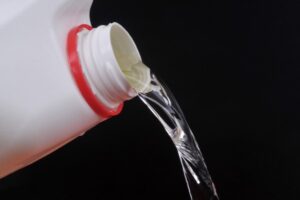Bleach is a common cleaner found in most homes, but is it safe to use in homes with PVC piping? In short, yes. You can safely use bleach to clean and disinfect your PVC pipes, as long as you dilute it first and avoid mixing it with other chemicals.
Getting Familiar with Bleach—What is it?
Bleach is a widely used and incredibly versatile cleaner. Its chemical name is sodium hypochlorite, but put simply, it’s saltwater that has been altered through electrolysis. Bleach is an effective disinfectant used for cleaning bathrooms and kitchens, but it’s also commonly used to remove stains and whiten laundry. Many people also use bleach for removing pipe blockages.
Is Bleach Safe to Use with PVC Piping?
PVC pipe has a unique chemical makeup that makes it durable and resistant to things like corrosion. While certain cleaners may not be compatible with PVC piping, bleach is usually safe to use in most applications, as long as it’s used properly.
Cleaning PVC Pipes with Bleach
While many reach for the bleach when water begins to back up in toilets and drains, they may find it’s safe, but ineffective. That’s because bleach will not break down or dissolve things like hair or inorganic materials quickly. For de-clogging, it’s best to reach for an enzyme type drain cleaner.
Bleach can, on the other hand, be an incredibly effective cleaner for removing algae growth or mold on both the inside and outside of your PVC piping (shop pvc piping at PVCFittingsOnline.com). While it’s safe to go down drains, it’s not safe to mix with other chemicals. In fact, mixing bleach with things like ammonia or even vinegar can create poisonous gases that can cause damage to your piping and your health. Before you add bleach, run water for several minutes first to ensure any chemical residue is flushed away and diluted.
If your PVC pipe is exposed, you may be wondering how to clean the outside. Bleach will not remove ink and lettering from the outside of your PVC—acetone is best for that—but it can disinfect the pipe and remove other stains safely.
Things to Consider
Dilute the Bleach
Full strength bleach isn’t necessary in most situations. Whether you are removing stains off the outside of the pipe or removing algae and growth from the inside, diluted bleach will be both safe and effective. One part bleach to two parts water can be used for tough stains, while one part bleach to four parts water should be used for regular cleaning and disinfecting.
Don’t Mix Bleach with Other Chemicals
When bleach is mixed with other chemicals, poisonous chlorine gas is released. Both ammonia and vinegar can react with bleach in this way, and because they are in a wide variety of other cleaners, it’s best to avoid mixing bleach with any other cleaner. Even if it’s been a while since you used other cleaners in your drains and pipes, be sure to flush your pipes fully with water first.
Use the Right Cleaner for the Job
Bleach is a great choice for disinfecting or removing stains, but it’s probably not the best choice for every cleaning application. For clogs, a drain cleaner may be best, and acetone is effective at removing lettering from the outside. Bleach may also damage the glaze on certain toilets or sinks, so consider spot checking before use.

